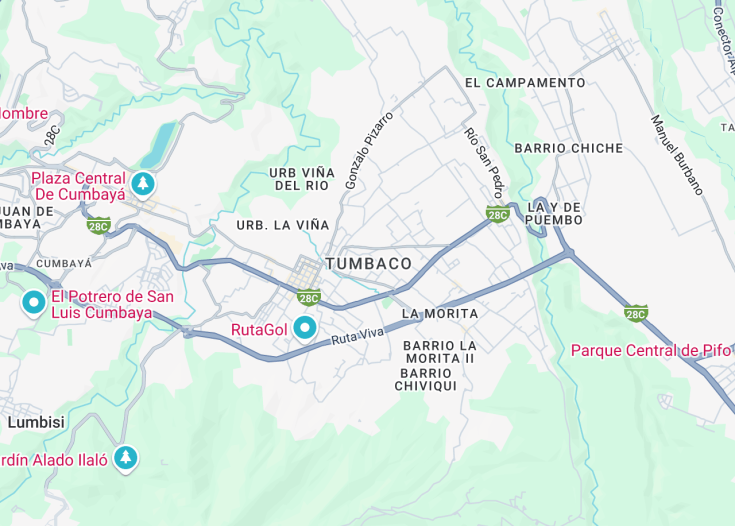Nestled in the verdant valleys of Ecuador, Tumbaco is a hidden gem just east of Quito. This tranquil town offers a perfect blend of cultural richness and natural beauty, ideal for travelers seeking a serene escape from the bustling city life. Tumbaco’s mild climate and scenic landscapes make it a favorable destination for outdoor enthusiasts and cultural aficionados alike. Visitors can explore local markets, traditional cuisine, and nearby hiking trails, providing a comprehensive experience of Andean life.
Ensure to visit the local markets in Tumbaco to experience the vibrant array of fruits and vegetables unique to the region, along with artisan crafts.
Planning your visit? Try to coincide with one of the town’s festive celebrations like the Tumbaco Festival of Lights for a truly memorable experience.
How to best experience Tumbaco?
Tickets, tours, and activities for Tumbaco are available at these providers:
Click on the logos below to easily compare prices.

Feeling lucky? Try the direct search:
GetYourGuide.com Viator.com Trip.com Expedia.com Tiqets.com Ctrip.com (中文)
Tumbaco: the tranquil valley near Quito
| Country | Ecuador |
| Time in Tumbaco | GMT-5 |
| Language spoken | Spanish |
| Population | 10,820 (2021 Census) |
| Currency | Ecuadorian sucre (Symbol: $, Code: ECS) |
| Airports |
|
Tumbaco, an inviting suburban valley nestling in the shadows of the iconic Illinizas and Cotopaxi volcanoes, is only a stone’s throw from Ecuador’s capital, Quito. Historically rooted in pre-Columbian cultures, Tumbaco has transformed into a serene refuge that balances modernity with rich cultural heritage. This region is not only known for its picturesque landscapes but also for its vibrant local markets and festivals that showcase the traditional Andean lifestyle. The climate is pleasantly mild throughout the year, making it an ideal location for nature enthusiasts and retirees alike.
Where is Tumbaco?
Tumbaco is conveniently located in the Pichincha province, just east of Quito, Ecuador’s capital.
Distances:
| Route | Distance by car | Time by car |
|---|---|---|
| Quito to Tumbaco | 13 miles (21 kilometers) | 25 minutes |
| Cumbayá to Tumbaco | 5 miles (8 kilometers) | 10 minutes |
What is Tumbaco famous for?
Tumbaco is renowned for its ideal climate and lush valleys, offering a peaceful suburban lifestyle with convenient access to Quito. It is popular among expatriates and locals for its less congested environment and higher living standards.
History
Pre-colonial era (Before 1534)
The region now known as Tumbaco was originally inhabited by indigenous tribes, predominantly the Quitus, who were part of the larger ethnic group known as the Yumbos. These early inhabitants lived a primarily agricultural and trade-based life, utilizing the fertile valleys and strategic location near the trade routes that connected the mountains and the coast. Archaeological evidence suggests the presence of a sophisticated network of trails and settlements that facilitated this trade.
Colonial period (1534-1820)
With the arrival of the Spanish conquerors in the 16th century, Tumbaco saw significant changes. The area was claimed by the Spanish Empire, leading to the establishment of colonial rule and the introduction of European agricultural practices and new crops. The region became an important outpost for the colonial administration, providing food supplies to the burgeoning city of Quito. The period was also marked by the construction of churches and the spread of Christianity, alongside the exploitation and decrease of the indigenous population.
Republican era (1820-Present)
Tumbaco gained more prominence after Ecuador’s independence in the early 19th century. As the country underwent various political and social changes, Tumbaco remained primarily agricultural, though it began to diversify economically in the 20th century. Modern-day Tumbaco is known for its picturesque landscapes, cultural heritage, and as a favored residential area for those seeking a quieter alternative to the hustle and bustle of nearby Quito. It has successfully melded its rich historical past with modern amenities, positioning itself as a unique destination within Ecuador.
Visit Tumbaco
What to see and do in Tumbaco
Explore the cultural heritage and natural beauty of Tumbaco. Visit the colonial churches that dot the landscape, offering insight into the region’s rich history. Enjoy outdoor activities such as hiking and biking along the Chaquiñán trail, a route that was once part of the historical trade paths used by the original inhabitants. The trail offers stunning views and a chance to reconnect with nature.
- Visit La Casa de Hacienda, a restored colonial manor that now serves as a museum.
- Explore local markets where artisans sell handmade crafts, perfect for unique souvenirs.
- Relax in the Parque de Tumbaco, a central spot that hosts cultural events and is ideal for a family day out.
Cultural and seasonal events
Tumbaco is vibrant with cultural festivities throughout the year. The most notable is the ‘Fiesta de Tumbaco,’ held annually in December. This festival features a mix of religious events, parades, and musical performances, celebrating the town’s patron saint with great fervor and community participation.
Best time to visit Tumbaco
The best time to visit Tumbaco is between June and September when the weather is drier and the landscapes are lush. This period provides the ideal conditions for enjoying both the natural scenery and outdoor activities.
Is Tumbaco worth visiting?
Tumbaco is undoubtedly worth visiting, especially for those seeking a blend of historical depth and natural beauty. Its proximity to Quito makes it an accessible escape to quieter, more picturesque surroundings. Tumbaco offers a unique glimpse into the region’s colonial past, vibrant present, and promises a rejuvenating experience for all visitors.

